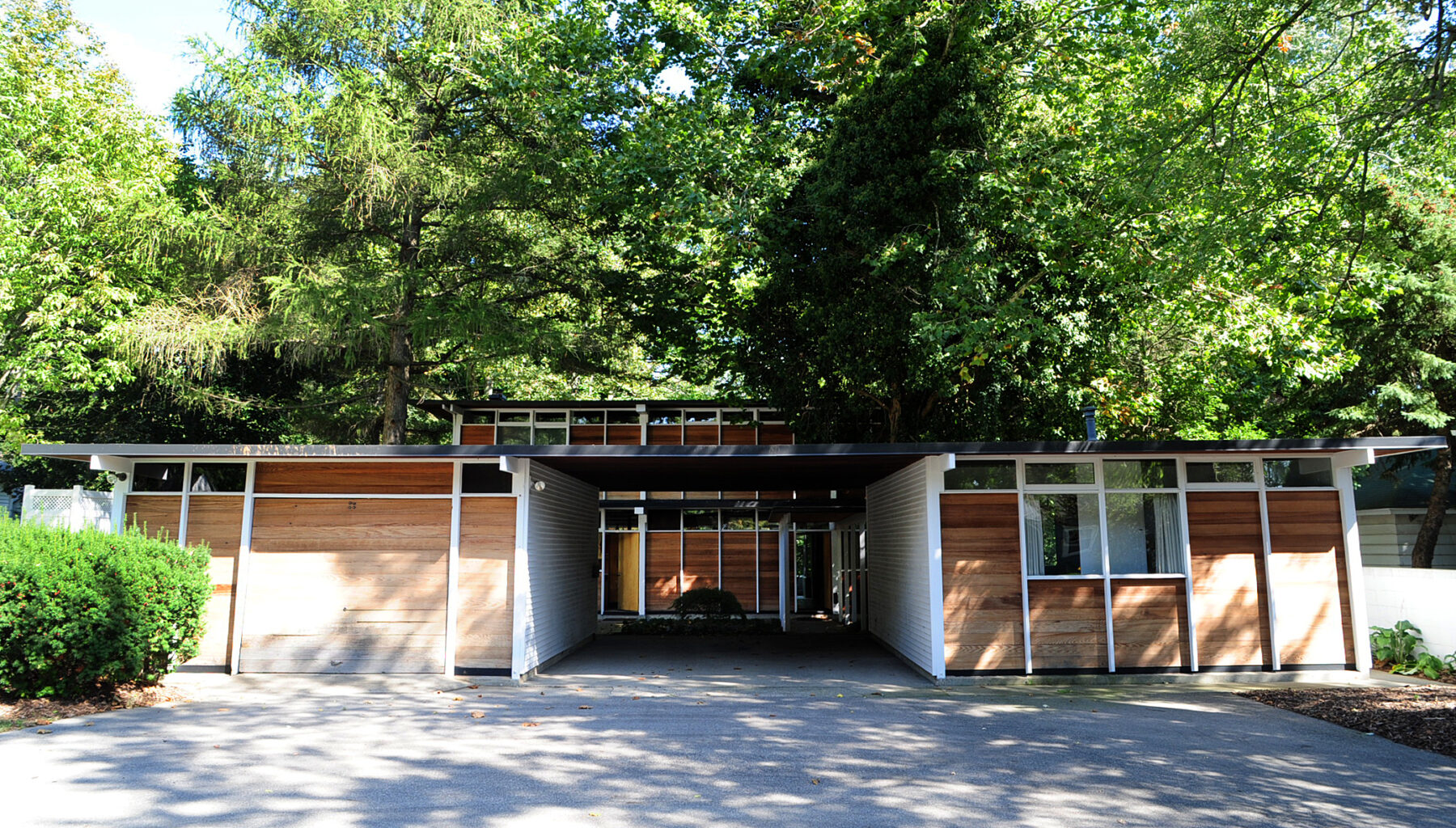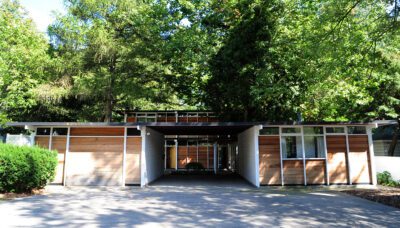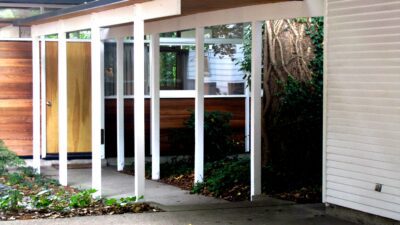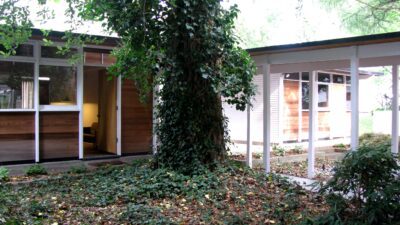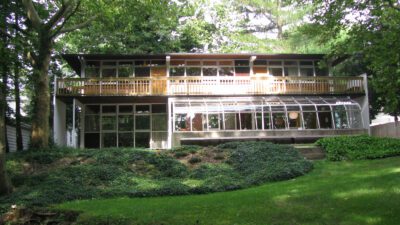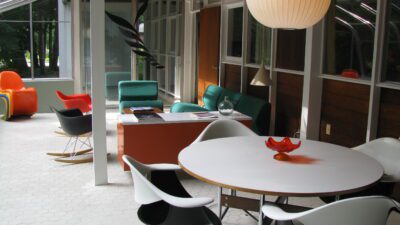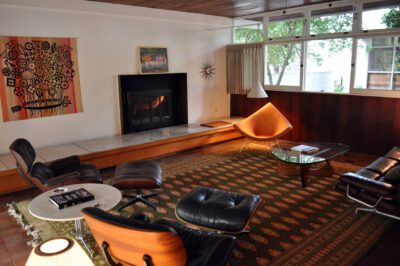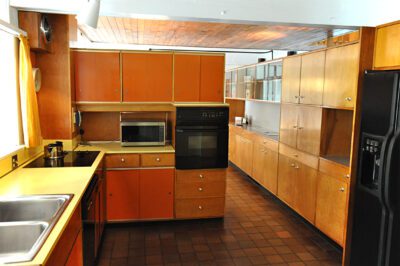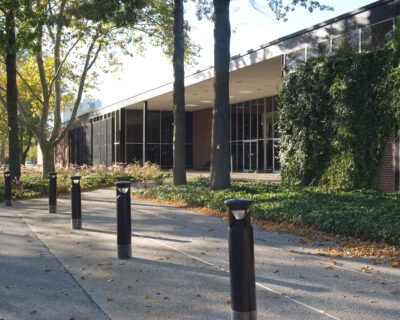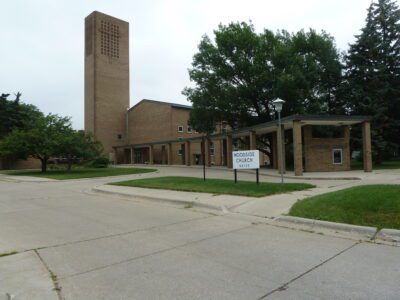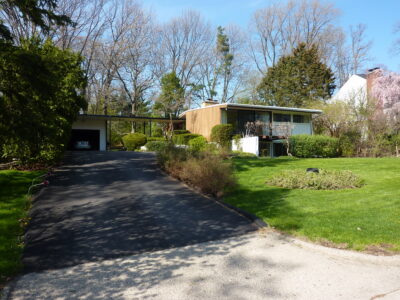The classically modern structure of the Max and Esther De Pree House sits in a modest neighborhood of small homes in Zeeland, not far from the headquarters of Herman Miller, Incorporated, the company that De Pree's father founded and that championed modern design beginning in 1930. The house is fronted by two symmetrical structures: one a single-car garage, the other a study. A covered walkway between the two leads to the house, a rectangular, flat-roofed, two-story building of two thousand square feet. Constructed of modules contained between vertical members, the exterior displays windows designed to maximize airflow and solid wood. For privacy, the natural cedar-clad sides of the house have no windows. Large windows at the rear of the house look out into a wooded area sloping down to a stream.
The downstairs is divided only by a large storage element running from side to side. The large living room/dining area has a fireplace and is designed for family activities and entertaining. A glassed-in sitting area that opens off the kitchen and living room was added after initial construction. A stairway rises to the left from the entrance area. The upstairs has three bedrooms, two bathrooms, and an activity area in the middle. Built-in storage separates the master bedroom from the activity area, which opens out on to a small roof-top deck in the rear.
The Herman Miller Furniture Company began its association with Charles and Ray Eames in 1946 through the efforts of George Nelson, the company's design director at the time. From then until Charles' death in 1978, the company maintained close ties with the Eameses and manufactured all of their most famous furniture designs.
In 1953, Max De Pree admired a model house design in the Eames Office in Los Angeles, and casually asked if he could build it in Michigan. Charles declined but offered to design another house for Max, his wife Esther, and their two children at the time. Max recalls that their discussions of the new design began with Eames asking about how the family lived. "We never discussed a fee," Max remembers, "and Charles on his few visits to the site spent most of his time playing Jacks with our daughter Jody." The house was completed in 1955 on a lot next to the small house the De Prees were living in.
Early in his career, Charles Eames had designed a very few houses while living and working in St Louis. One of these, the Meyer House, was decidedly modern in design, markedly different from Eames's earlier and more traditional houses. The house caught the eye of Eliel Saarinen, director of the Cranbrook Academy of Art, who offered Eames a year-long fellowship in 1938. This was the launching point of Charles Eames as one of the world's most well-known industrial designers. He developed early ideas for furniture, met and married Ray Kaiser, and formed invaluable connections with Eero Saarinen, Don Albinson (who worked many hours on the design of the De Pree house), and Harry Bertoia.
The Eameses became known for their furniture, their films and exhibits, and their house and office in Pacific Palisades. The De Pree house was a rare excursion for Charles in residential architecture after his early efforts and after his leadership in modern design had been fully established. The De Pree House shares many of the attributes of the Case Study homes built in California, but the house was designed to take advantage of local craftsmen and in light of Michigan winters. The lighting was originally low-voltage, an innovation at the time. The ceilings are solid four-by-three, double tongue-and-groove cedar beams. The walls are panels of veneered plywood manufactured in the Herman Miller plant. The De Prees owned and occupied the house until 1975, when it was sold to Bob Rynbrandt, a Herman Miller employee. He and his family lived in the house until 2010 when Herman Miller, Inc. bought the house with plans to restore and preserve it.

